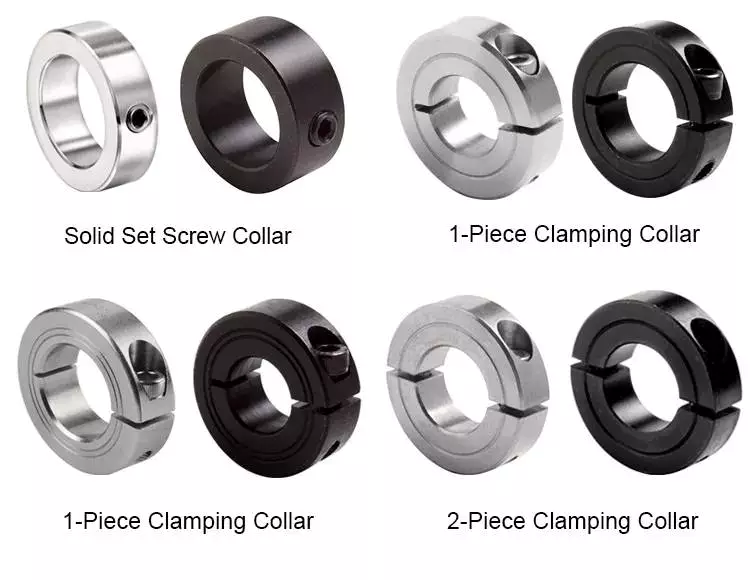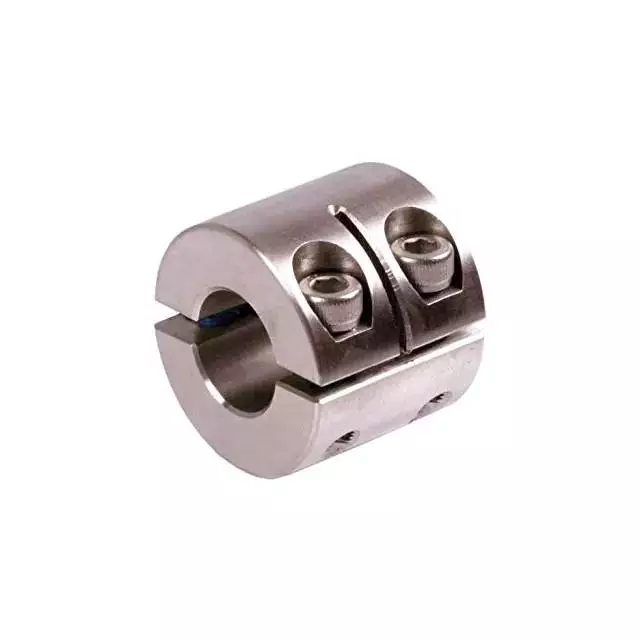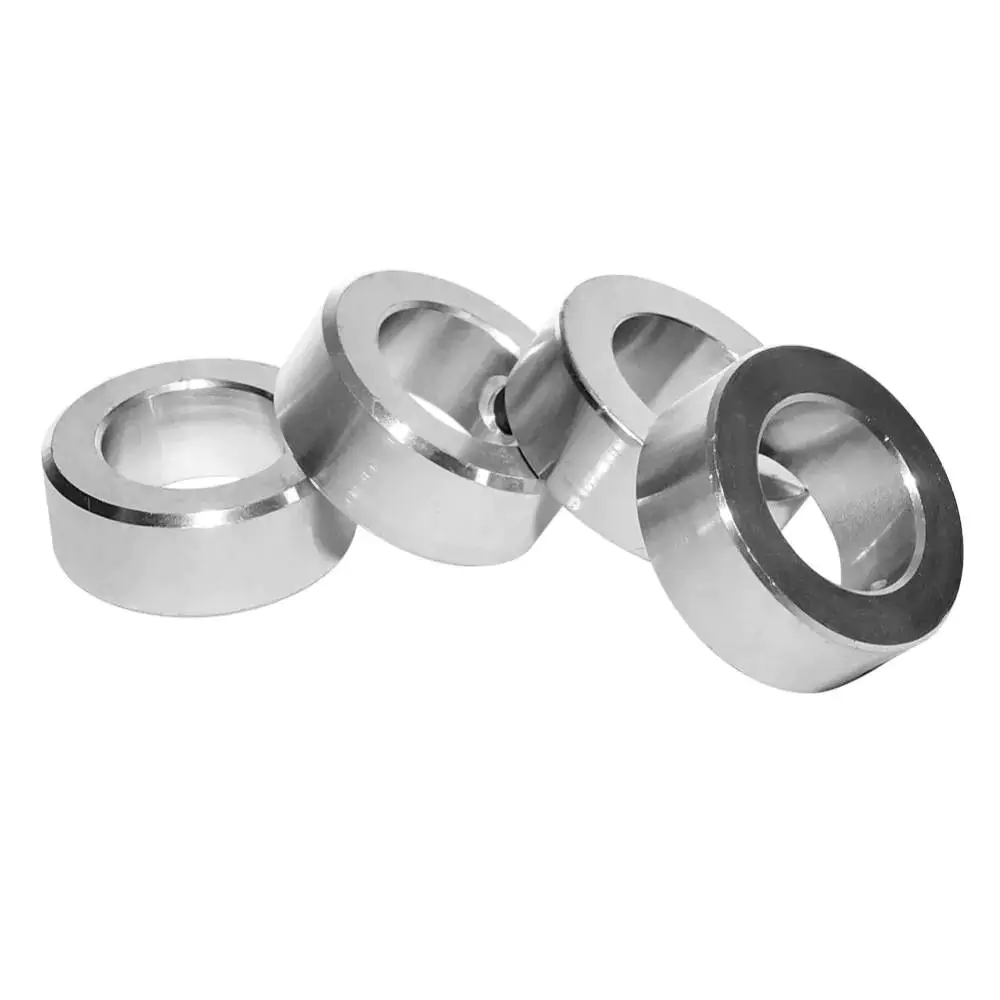Product Description
Standard and Non Standard Stainless Carbon Steel Double Split Shaft Collar
| Type | Feature |
| Setscrew Type | Metric Size |
| Inch Size | |
| Splits type | Single split/one piece split |
| Double split/2 pieces splits | |
| Material | Steel/Aluminum/Stainless steel |
| Surface Treatment |
Black oxide/zinc plated other specified treatment. |
Use:
are used in a variety of application and industries. Examples include agricultural implements, office machines, exercise equipment, mixers, and printing presses.A variety ofspecialized products are available. Knurled shaft collars provide a friction surface for hand gripping and are suitable for conveyors and other applications which require frequent collar adjustment.
Hexagonal-bore shaft collars are suitable for power transmission and drive applications.
Heavy-duty shaft collars feature large cross sections and sturdy clamping screws for added holding power.
Because heavy-duty shaft collars provide better vibration and shock resistance,
they are designed for applications such as off-road, mining, paper and steel mill equipment.
Main Products:
1. Timing Belt Pulley (Synchronous Pulley), Timing Bar, Clamping Plate;
2. Forging, Casting, Stampling Part;
3. V Belt Pulley and Taper Lock Bush; Sprocket, Idler and Plate Wheel;Spur Gear, Bevel Gear, Rack;
4. Shaft Locking Device: could be alternative for Ringfeder, Sati, Chiaravalli, Tollok, etc.;
5. Shaft Coupling:including Miniature couplings, Curved tooth coupling, Chain coupling, HRC coupling, Normex coupling, Type coupling, GE Coupling, torque limiter, Universal Joint;
6. Shaft Collars: including Setscrew Type, Single Split and Double Splits;
7. Gear & Rack: Spur gear/rack, bevel gear, helical gear/rack
8. Other customized Machining Parts according to drawings (OEM).
More Advantages:
1. More competitive prices,
2. Shorter delivery date: 35 days.
3. We are the professional manufacturer in the field of Power Trans. Parts,specially for Timing Pulleys.
4. Produce standard and non-standard
5. Strict QC Management:ISO9001:2008,our engineer,Mr.Wang has specialized in the prodcution for over 20 years.
Packaging & Shipping:
All the products can be packed in cartons,or,you can choose the pallet packing.
MADE IN CHINA can be pressed on wooden cases.Land,air,sea transportation are available.UPS,DHL,TNT,
FedEx and EMS are all supported.
Company:
Factory View:
Exhabition:
FAQ:
1. MOQ
A: Generally, 1 pc for standard parts; contact for nonstandard parts.
2. Delivery Time
A: In stock: within 5 working days. Out of stock: depends on your order quantity.
3. How To Select
A: part number or drawing, catalogue. If no, you can send us your sample, so we can make the drawing and sample accordingly.
4: What is the Warranty for your products?
A:Normally our warranty is 1 year.
/* January 22, 2571 19:08:37 */!function(){function s(e,r){var a,o={};try{e&&e.split(“,”).forEach(function(e,t){e&&(a=e.match(/(.*?):(.*)$/))&&1
| Standard Or Nonstandard: | Standard & Custom |
|---|---|
| Shaft Hole: | Standard & Nonstandard |
| Bore Diameter: | 8-65 |
| Material: | Steel/Aluminum/Stainless Steel |
| Type: | Collar |
| Service: | Standard and Custom |
| Samples: |
US$ 1/Piece
1 Piece(Min.Order) | |
|---|
| Customization: |
Available
| Customized Request |
|---|

Can I get recommendations for shaft collars suitable for use in harsh environments?
Yes, there are specific types of shaft collars that are designed to withstand harsh environments and provide reliable performance. When selecting shaft collars for use in such conditions, it is important to consider factors such as temperature extremes, exposure to moisture or chemicals, abrasive environments, and high vibration or shock. Here are some recommendations for shaft collars suitable for use in harsh environments:
- Stainless Steel Shaft Collars: Stainless steel shaft collars are highly resistant to corrosion and can withstand harsh environments with exposure to moisture, chemicals, or abrasive substances. They offer excellent durability and are suitable for applications in industries such as marine, food processing, chemical processing, or outdoor equipment where reliability and resistance to rust and corrosion are critical.
- Plated Shaft Collars: Plated shaft collars, such as zinc-plated or nickel-plated collars, provide an added layer of protection against corrosion and wear. These collars are often used in harsh industrial environments where exposure to chemicals, humidity, or outdoor elements is a concern. The plating helps to prevent rust and can extend the lifespan of the collars in challenging conditions.
- Shaft Collars with Seals or Gaskets: Some shaft collars are designed with integrated seals or gaskets to provide additional protection against moisture, dust, and contaminants. These collars create a barrier between the collar and the shaft, preventing the entry of debris or liquids. They are commonly used in applications where water or dust ingress is a potential issue, such as outdoor equipment, agricultural machinery, or industrial machinery in dusty environments.
- High-Temperature Shaft Collars: For harsh environments with high-temperature conditions, it is important to select shaft collars that can withstand the heat without deformation or degradation. High-temperature shaft collars, often made from heat-resistant alloys or ceramics, are designed to handle extreme temperatures. These collars are suitable for applications in industries such as aerospace, automotive, or furnace equipment where exposure to high heat is a concern.
- Specialized Coatings or Materials: In some cases, specialized coatings or materials can be applied to shaft collars to enhance their resistance to specific harsh conditions. For example, coatings such as Teflon or epoxy can provide additional protection against chemicals or abrasion. Additionally, certain materials like titanium or Hastelloy offer superior resistance to corrosion and can be utilized in highly corrosive environments.
When choosing shaft collars for harsh environments, it is recommended to consult with manufacturers or suppliers who have expertise in providing solutions for challenging conditions. They can offer guidance on selecting the most suitable collar materials, designs, and additional features based on your specific application requirements and the severity of the harsh environment.

Where can I find information on the materials used in manufacturing shaft collars?
If you are looking for information on the materials used in manufacturing shaft collars, there are several sources where you can find relevant information. Here are some common resources to consider:
- Manufacturer Websites: Many manufacturers of shaft collars provide detailed information about the materials they use in their product specifications or technical datasheets. Visiting the websites of specific collar manufacturers and exploring their product documentation or resources section can help you find information about the materials used in their collars. This information may include the type of material (such as steel, stainless steel, aluminum, or plastic) and any specific properties or characteristics associated with the material.
- Product Catalogs and Brochures: Manufacturers often publish product catalogs or brochures that provide an overview of their collar offerings. These catalogs may include information about the materials used in manufacturing the collars. You can request catalogs from manufacturers directly or check their websites for downloadable versions. The catalogs may highlight the material properties and advantages of using specific materials for different applications.
- Material Databases: Online material databases or directories can be valuable resources for finding information about specific materials used in manufacturing shaft collars. These databases typically provide comprehensive information about various materials, including their composition, mechanical properties, corrosion resistance, temperature tolerance, and other relevant characteristics. Examples of such databases include MatWeb, Engineering Toolbox, or specialized materials databases maintained by industry organizations or universities.
- Technical Standards and Specifications: Technical standards and specifications related to mechanical components can often include information about the materials used in their construction. Standards organizations or industry associations may release documents that outline the material requirements for shaft collars or provide guidelines for material selection. Accessing these standards or specifications can provide insights into the recommended materials for shaft collar manufacturing.
- Consulting with Manufacturers or Suppliers: If you have specific questions about the materials used in manufacturing shaft collars, reaching out directly to manufacturers or suppliers can be beneficial. They can provide detailed information about the materials they use, including their composition, properties, and any specific treatments or coatings applied to enhance performance. Contacting manufacturers or suppliers allows for direct communication and the opportunity to address any specific concerns or requirements you may have.
When seeking information on materials used in shaft collar manufacturing, it is important to consider factors such as desired properties (e.g., strength, corrosion resistance), environmental compatibility, and application-specific requirements. This will help you make informed decisions about selecting shaft collars that are suitable for your specific needs and operating conditions.

Are there tutorials on the proper installation of shaft collars?
Yes, there are tutorials available that provide guidance on the proper installation of shaft collars. These tutorials can be helpful for individuals who are unfamiliar with the installation process or want to ensure that they are installing the collars correctly. Here are some common sources where you can find tutorials on the installation of shaft collars:
- Manufacturer Websites: Many manufacturers of shaft collars provide detailed installation instructions on their websites. These instructions may include step-by-step guides, diagrams, or videos that demonstrate the proper installation techniques. Visiting the websites of specific collar manufacturers and exploring their resources section or product documentation can help you find the installation tutorials you need.
- Online Industrial Communities and Forums: Industrial communities and forums dedicated to mechanical components or equipment often have discussions or threads related to the installation of shaft collars. Participating in these communities and posting inquiries about installation techniques can help you connect with professionals or experienced users who can provide guidance or share their knowledge.
- Video Sharing Platforms: Platforms like YouTube or Vimeo host a wide range of instructional videos, including tutorials on the installation of various mechanical components. Searching for “shaft collar installation tutorial” or similar keywords on these platforms can yield helpful videos that visually demonstrate the proper installation techniques. Watching these videos can provide a clear understanding of the installation process and any specific considerations to keep in mind.
- Trade Publications and Magazines: Trade publications or magazines related to mechanical engineering, industrial equipment, or power transmission may feature articles or guides on the installation of shaft collars. These resources often provide detailed explanations, tips, and best practices for proper installation. Checking these publications or their online platforms can give you access to written tutorials or expert insights.
- Online Documentation and Manuals: Some manufacturers or suppliers provide downloadable documentation or manuals for their shaft collars. These documents may include installation instructions along with other technical information. Searching for the specific collar model or brand, followed by keywords like “installation instructions” or “user manual,” can help you find relevant documentation that covers the installation process.
When using tutorials for shaft collar installation, it is important to ensure that the information is sourced from reputable and reliable sources. Follow the provided instructions carefully, and if in doubt, consult with professionals or seek guidance from the manufacturer. Proper installation of shaft collars is crucial for their effectiveness, reliability, and the overall performance of the machinery.


editor by CX 2024-04-08
by
Tags:
Leave a Reply